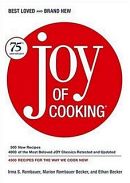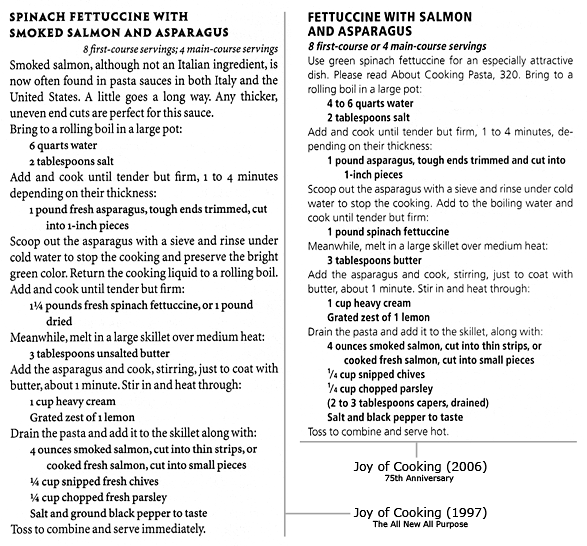 There have been a total of eight versions of Joy of Cooking published since Irma Rombauer self-published her book of recipes collected from family, friends, and neighbors in 1931. Joy of Cooking was then picked up by a publisher and Irma expanded it from over 1,000 to over 2,500 recipes. By 1975, when the most successful and famous version of Joy of Cooking was published, over 4,500 recipes (and 1,000 illustrations) were part of the package. (Compare the number of recipes to the 1,000 that The New Best Recipe has or the 100-150 recipes that a Rachael Ray cookbook contains.)
There have been a total of eight versions of Joy of Cooking published since Irma Rombauer self-published her book of recipes collected from family, friends, and neighbors in 1931. Joy of Cooking was then picked up by a publisher and Irma expanded it from over 1,000 to over 2,500 recipes. By 1975, when the most successful and famous version of Joy of Cooking was published, over 4,500 recipes (and 1,000 illustrations) were part of the package. (Compare the number of recipes to the 1,000 that The New Best Recipe has or the 100-150 recipes that a Rachael Ray cookbook contains.)In 1997, a completely revised version of Joy of Cooking was released that was more like a re-imagining of the original than an updated edition. There were both good and bad things about this version. A lot of topics were dropped from the previous edition while microwave ovens, food processors, and "exotic" ingredients were given appropriate attention. Unfortunately, the tone of the cookbook also changed. A multitude of authors contributed to the content and the personal voice of the prior editions had almost completely disappeared. Although it contains a great deal of information beyond recipes, it reads like a recipe book instead of the great all purpose resource on learning to cook that the Joy of Cooking name represents to so many. Another problem that I found with the 1997 edition is that some of the recipes were unreliable (such as the 14-in-1 master cookie recipe) -- a problem others have attributed to insufficient testing and relatively low standards of quality when preparing the 1997 edition (small wonder, with so many recipes to revise and test and a team that already spent over three years on the material). (My copy of the 1997 edition also had a weak binding causing pages to start becoming partially detached.)
Related Articles
 As compared to the 1997 edition, the layout and font have been modernized. Making the book easier to reference while in the kitchen, a clean, crisp sans serif font replaces the old serifed ones. As a result, the signature method of listing ingredients (within the recipe procedures, indented, and bold) is much easier to spot and read. In addition, the introduction of symbols to highlight important principles and high-altitude tips makes it easier to find helpful pointers. The image shows the same recipe from both the 1997 (on the left) and the 2006 (on the right) editions to demonstrate the updated recipe style as well as typography design.
As compared to the 1997 edition, the layout and font have been modernized. Making the book easier to reference while in the kitchen, a clean, crisp sans serif font replaces the old serifed ones. As a result, the signature method of listing ingredients (within the recipe procedures, indented, and bold) is much easier to spot and read. In addition, the introduction of symbols to highlight important principles and high-altitude tips makes it easier to find helpful pointers. The image shows the same recipe from both the 1997 (on the left) and the 2006 (on the right) editions to demonstrate the updated recipe style as well as typography design.Naturally, if you don't have a copy of Joy of Cooking, you should pick up a copy of the 75th Anniversary Edition - it'll soon become your go to cookbook for finding the "standard" recipe for just about any dish you'd expect to be prepared in an American home. If you already have a previous edition, then this new edition is a great replacement/update (especially if you have the 1997 version).
Also, be sure to check Simon & Schuster's errata page for any misprints.
Related Articles

I can't believe I forgot to link to the books. I put in links to both the 2006 edition and the 1997 edition (don't buy this one, just look at the picture to help you identify if you own it...) into the article.
75th Anniversary Joy of Cooking (2006)
The All New, All Purpose Joy of Cooking (1997)
Try that link...
Dominic
the zen kitchen
http://www.kaboodle.com/reviews/cabinet-fold-down-acrylic-cookbook-rack
if your layout permits a "good spot" it a boon - works for JOC - but the "oversized" formats don't fit on the platform.